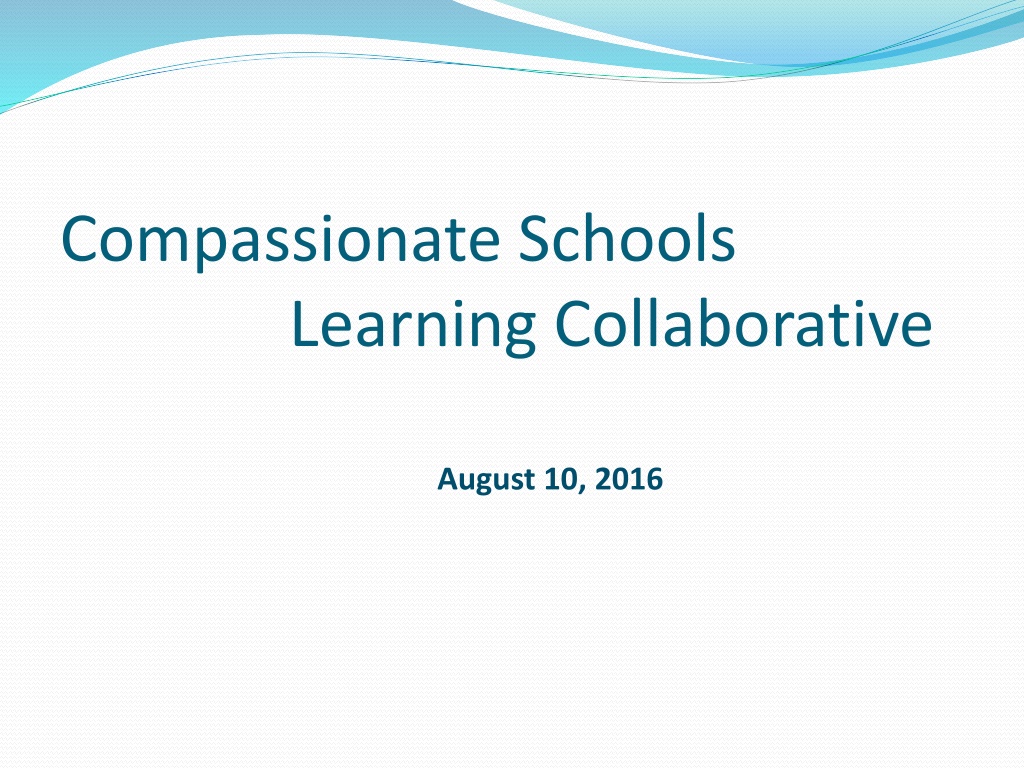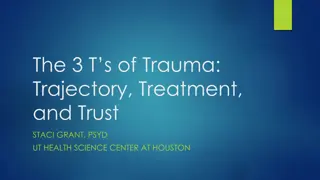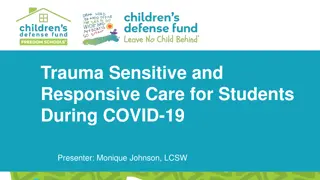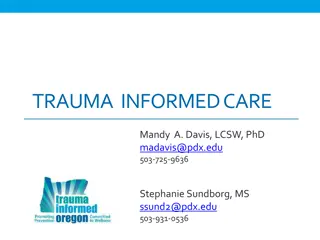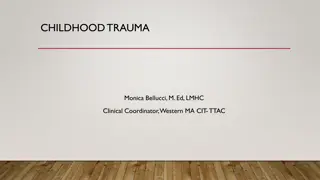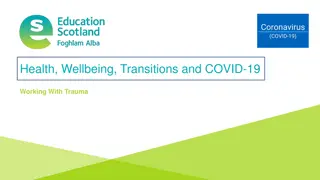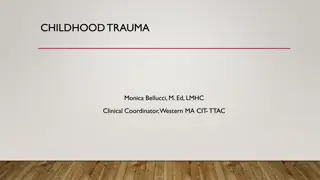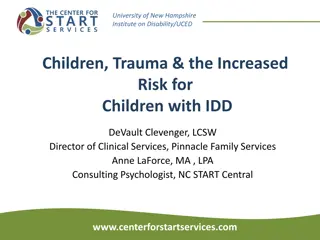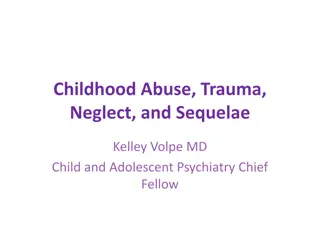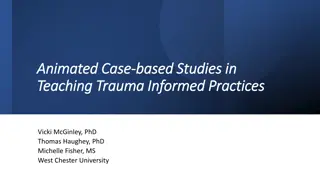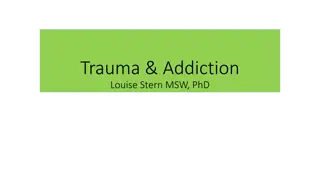Understanding Childhood Trauma's Impact on Academic Performance
Exposure to childhood trauma can significantly impact students' academic performance and overall well-being. Assessing and intervening for trauma in schools is crucial to improving outcomes, as students with Adverse Childhood Experiences (ACEs) are more likely to struggle academically and exhibit social, emotional, and behavioral challenges. By addressing trauma and providing appropriate support, schools can help students feel connected, engaged, and successful in their learning journey.
- Childhood trauma
- Academic performance
- Adverse Childhood Experiences
- School intervention
- Student well-being
Download Presentation

Please find below an Image/Link to download the presentation.
The content on the website is provided AS IS for your information and personal use only. It may not be sold, licensed, or shared on other websites without obtaining consent from the author. Download presentation by click this link. If you encounter any issues during the download, it is possible that the publisher has removed the file from their server.
E N D
Presentation Transcript
Compassionate Schools Learning Collaborative August 10, 2016
District Change Champion Dr. Michele Marinucci Director Special Services Woodbridge School District
Building Change Champion Ms. Michelle Jones Assistant Principal George Read Middle School Colonial School District
ASSESSMENT for Change and Outcomes Improve students feelings of connectedness, academic engagement and adaptive behaviors. Evaluate district/school processes and systems.
Why Should Schools Screen and Intervene for Trauma? Exposure to traumatic events in childhood is common ACE Study: 2/3 reported exposure to at least one event before 18 http://www.cdc.gov/violenceprevention/acestudy/ National Survey of Children s Exposure to Violence: 61% of children ages 12-17 had already experienced at least one exposure to some form of violence http://www.unh.edu/ccrc/projects/natscev.html National Survey of Children s Health: 25% exposed one event; 23% exposed to two http://childhealthdata.org/learn/NSCH The majority of children don t receive treatment As many as 60-90% of children who need mental health treatment don t receive it
Childhood Adversity and School Performance Students with ACEs are more likely to score lower on standardized achievement testing (Goodman et al, 2011) show decrease in IQ, reading achievement and language skills (Delaney-Black et al, 2002) be retained- 2.5 x (Grevstad, 2007; Sanger et al 2000, Shonk et al 2001) Be suspended and expelled (Sanger et al, 2000) be placed in special education services. One study found that children with four or more ACE s were 32 times more likely to be labeled with learning or behavioral problems than a child with no ACE s. (Burke Harris, 2011)
Toxic Stress: Social, Emotional and Behavioral Indicators Social/Emotional Difficulty taking someone else s perspective Can t modify behavior in response to social cues Social isolation- challenge navigating social relationships Poor emotional regulation Behavioral Somatic complaints Demonstrate impulsivity, aggression, defiance, withdrawal Alcohol, tobacco and other drug use: vulnerable to early initiation Develop formal mental health disorders: depression (including suicide), PTSD
Screening for Relationships and Belong: Connect the Dots
Screening to Mediate Risk and Vulnerability: Behavior Intervention Monitoring and Assessment System
Assessment for Prevention and Intervention Strategy Multiple Gating Technique Gate #1: CAST A WIDE NET Ratings of student behavior. Gate #2: REFINE THE CATCH Grade-level PLCs rank and prioritize. Gate #3: IDENTIFY THOSE MOST VULNERABLE Observations, discipline history, interviews, prior response to interventions. (Minke, 2012)
Screening Tools Behavior and Emotion Screening System (BESS), Pearson Clinical Strengths and Difficulties Questionnaire (SDQ) Teacher-developed measure
Hamilton Subject: math/science Lying, Cheating, Sneaking Low Academic Achievement Does Not Complete Assignments Stealing Behavior Problems Peer Rejection Negative Attitude Aggressive Behaviors Arrives Tardy Disrupts Class Unprepared for Class TOTAL 0 0 0 0 3 0 0 0 2 0 1 6 1 2 0 2 3 1 0 0 0 1 0 10 0 0 2 2 1 2 2 0 0 2 0 11 0 0 0 0 2 2 0 0 1 1 0 6 2 2 2 0 3 1 2 2 3 2 2 21 0 0 0 0 1 0 0 0 2 1 1 5 0 0 1 0 2 0 2 2 3 3 2 15 0 0 1 0 1 0 0 0 0 2 1 5 0 0 0 0 1 0 0 0 1 0 2 4 0 0 0 0 2 0 0 0 0 0 0 2 0 0 1 0 1 0 0 0 2 2 2 8 0 0 3 0 1 2 2 0 0 3 0 11 0 0 2 0 2 1 0 3 2 2 2 14 0 1 2 0 3 2 0 3 3 3 3 20 0 0 1 0 2 2 0 0 2 2 0 9 2 2 3 2 3 2 2 3 3 3 3 28
Behavior Intervention and Monitoring Assessment System BIMAS Standard (34 items): Behavioral Concerns: Conduct Negative affect Cognition/attention Adaptive Scales Social Academic functioning BIMAS Flex Additional items in each area
District and School-wide report option Levels Of Functi oning Acade mic Functi oning Social Conce rn 281(45 %) 197 (32 %) Typica l 277 (44 %) 336 (54 %)
How are Schools Responding? Several states have developed focused education initiatives to address ACE and trauma exposure (e.g. Wisconsin, Washington State and Massachusetts) to create trauma-sensitive schools the approach often provides the infrastructure for positive behavioral support and includes both school-wide and individual strategies as well as a focus on staff self-care. trauma sensitive schools assure all staff have an understanding of the impact of trauma on learning trauma sensitive schools provide supports to help students feel safe physically, socially, emotionally and academically trauma sensitive schools focus on building youth and staff resilience
What is a Trauma-Sensitive School A trauma sensitive school is one that creates a culture that prioritizes safety, trust, choice, and collaboration. within a trauma-sensitive school, everyone (e.g., teachers, administrators, pupil services professionals, cafeteria staff, bus drivers, etc.) learns about the prevalence and impact of trauma in the lives of children and families. This awareness motivates and guides the examination and transformation of the school environment, policy/practice, educational strategies, staff training, and family involvement, etc. to ensure that children impacted by trauma can learn and be successful. Trauma sensitive schools ask what has happened to you? rather than what is wrong with you? .
Reflections and Next Steps Vision Sharing Next Steps The Power of Self-Care with Dorrell Green, Assistant Superintendent, Brandywine School District Book Discussions
